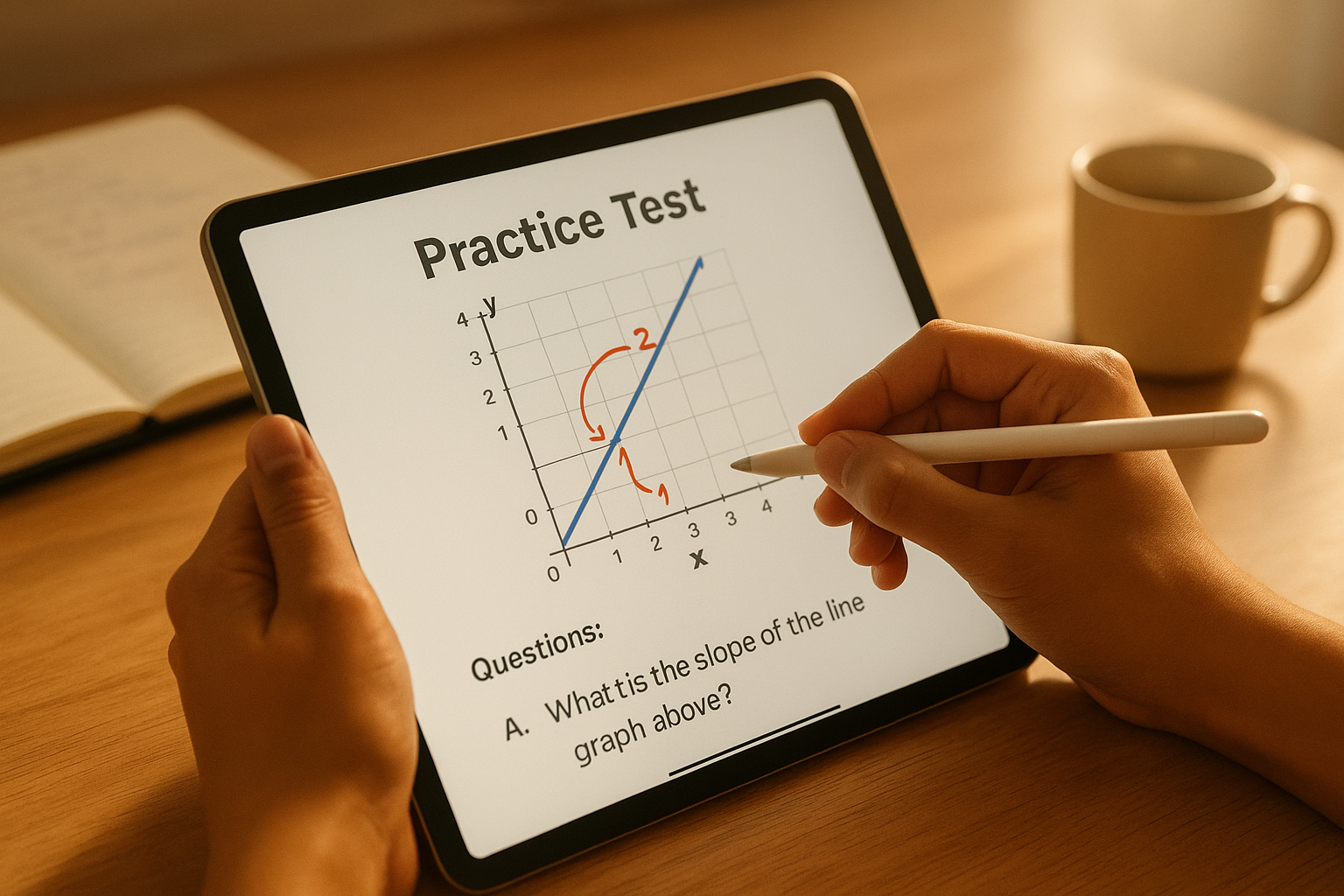The Digital SAT Isn’t Just a Test — It’s Everyday Practice in Disguise
When you open a Digital SAT practice module or sit down to take a full Bluebook practice test, it might feel very focused: graphs, passages, multi‑step math problems, and sentence revisions. But underneath those questions is a deeper truth: the Digital SAT trains ways of thinking you use all the time — from deciding whether to take the bus or drive, to planning a part‑time job schedule or spotting misleading headlines on social media.
This post walks through exactly how SAT skills map to everyday problem‑solving, with clear examples, short exercises you can try today, and a simple study plan you can adopt. I’ll also show where personalized help — like Sparkl’s one‑on‑one tutoring, tailored study plans, and AI‑driven insights — fits naturally into the process without sounding like an infomercial. Think of this as study advice and a lens for reframing practice so it feels useful beyond a test day score.
Why skills matter more than raw facts
It’s tempting to view the SAT as a collection of questions to memorize strategies for. In reality, the best gains come from building skills — the cognitive habits and frameworks you use to approach new problems. Skills are transferable. Once you can analyze a scatterplot or read an argument for evidence, you can apply the same habits to college readings, research projects, or real‑world decisions.
Here are the broad skill categories the Digital SAT exercises — and why they matter off the page:
- Quantitative reasoning and data literacy: Interpreting graphs, rates, and margins of error is basically information hygiene for the modern world.
- Critical reading and evidence‑based reasoning: Distinguishing main ideas from details, tracking an author’s logic, and evaluating sources keeps you from being misled.
- Problem decomposition: Breaking a complex prompt into smaller steps reduces overwhelm and improves accuracy.
- Time and resource management: The adaptive digital format rewards efficient approaches — a skill you’ll use in exams, work, and life.
- Pattern recognition and generalization: Seeing what’s repeated across problems helps you move from rote practice to strategic thinking.

Quick example: From SAT algebra to grocery budgeting
One SAT problem might ask you to compare unit prices or solve a proportional relationship. The same math shows up when you decide whether a bulk buy saves money after considering waste, shelf life, and storage. The SAT frames it in numbers; life frames it in choices. Practicing the SAT trains the habit of turning a real‑world scenario into a solvable numerical model.
How key SAT domains translate to everyday problem‑solving
Let’s unpack the main sections of the Digital SAT and translate them into real‑world skills and situations.
1) Problem‑Solving and Data Analysis (Math)
What it tests: ratios, rates, percentages, interpreting tables and graphs, probability, and evaluating claims from data. In short: quantitative literacy.
Everyday parallels:
- Understanding a news article that cites a survey: you’ll recognize sample size issues and margins of error.
- Comparing cell phone plans: converting different billing models into a consistent unit rate makes the best deal obvious.
- Interpreting trends: reading a weekly sales report or campus COVID dashboard requires the same skills as reading scatterplots and trend lines.
2) Command of Evidence and Reading for Information (Reading & Writing)
What it tests: locating evidence, comparing perspectives, summarizing central ideas, and following an author’s logic. This is applied critical thinking — not just reading, but making judgments about credibility and relevance.
Everyday parallels:
- Evaluating persuasive posts on social media: does the post cite evidence, and is that evidence relevant?
- Researching for a class project: selecting useful quotes and data and weaving them into a logical argument.
- Following complex instructions: extracting the steps you need and noticing assumptions or missing details.
3) Expression of Ideas and Editing (Writing)
What it tests: clarity, concision, and correct grammar in context. You rewrite sentences to improve meaning and flow — a useful editing muscle.
Everyday parallels:
- Writing emails and resumes: concise clarity helps your ideas land and saves readers time.
- Explaining plans to teammates: choosing precise wording avoids confusion.
- Crafting scholarship applications: a well‑edited paragraph can turn a good idea into a memorable one.
Real examples: walking through a few SAT‑style scenarios and their life equivalents
Seeing a direct comparison makes the transfer of skill more concrete. Below are common SAT scenarios and everyday tasks that rely on the same thinking.
Scenario A — Interpreting a graph
SAT task: Determine which statement about two plotted trends is supported by the graph.
Real life: You’re looking at the campus sustainability committee’s chart of energy use over five years. Is it fair to say the program reduced energy use, or do seasonal fluctuations explain the dip? The SAT trains you to check axes, scales, and context before leaping to conclusions.
Scenario B — Multi‑step algebraic reasoning
SAT task: Solve a two‑step equation embedded in a word problem (e.g., cost, tax, and discount calculations).
Real life: Planning a weekend fundraising bake sale: you estimate costs, projected sales, and leftover inventory. The same equations help you test scenarios rapidly and decide whether the event will meet your goals.
Scenario C — Evaluating an author’s argument
SAT task: Choose the best piece of evidence for a claim or identify a flawed inference.
Real life: Reading a column claiming a new phone reduces screen time. You ask: what data supports that? How was it measured? The SAT trains you to spot weak premises and overgeneralized conclusions.
Mini‑workouts: Daily practice that builds durable skills
Rather than long, unfocused study sessions, short targeted workouts build habits that stick. Try these 10‑minute exercises across a week:
- Monday — Data snapshot: Find a chart (news, campus newsletter, or class handout). Spend 10 minutes writing three true statements and one misleading claim someone might make about it.
- Tuesday — Precision editing: Take a paragraph from an essay and rewrite it to be 20% shorter while keeping meaning intact.
- Wednesday — Ratio check: Compare two subscription plans or two prices and compute unit rates; then list secondary factors that influence a decision (like convenience).
- Thursday — Evidence hunt: Read a short opinion piece and extract the top two pieces of evidence the author uses. Rate the strength of that evidence.
- Friday — Timed problem: Do one adaptive practice set (10–15 minutes) and then reflect: where did you rush and what could you annotate next time?
One table, two purposes: tracking progress and mapping skills to life
| Digital SAT Domain | Core Skill Built | Everyday Application |
|---|---|---|
| Problem‑Solving & Data Analysis | Quantitative reasoning, interpreting uncertainty | Budgeting, understanding surveys, reading dashboards |
| Command of Evidence (Reading) | Evaluating arguments, sourcing claims | Detecting bias in articles, better research for papers |
| Expression of Ideas (Writing) | Clarity, editing, rhetorical choice | Emails, scholarship essays, group communication |
| Adaptive response and strategy | Efficient decision‑making under time constraints | Studying, standardized tasks at work, meeting management |
How to study with transfer in mind: a simple 8‑week plan
The goal is to build robust skills, not just accumulate practice questions. This 8‑week outline balances deliberate practice, reflection, and real‑world application.
Weeks 1–2: Foundations and habits
- Daily: 20–30 minutes of targeted practice (data questions one day, reading short passages the next).
- Weekly: One full adaptive practice section to get used to the format.
- Reflection: Keep a one‑page log of mistakes and why they happened (content gap, careless error, timing).
Weeks 3–4: Skill consolidation
- Focus sessions on weak domains identified in your log.
- Integrate real‑world tasks: write a short summary of a news article using text evidence; analyze a price comparison using unit rates.
- Take one full practice test every other week and simulate test conditions at least once.
Weeks 5–6: Strategy and stamina
- Practice time management: set mini‑timers for sets of questions and practice selective skipping.
- Do mixed sets to improve adaptability between reading and math thinking.
- Polish editing skills with daily 10‑minute rewriting drills.
Weeks 7–8: Performance tuning
- Full practice tests under strict conditions every week.
- Targeted review sessions with detailed error analysis.
- Mock test day checklist and mental preparation routine.
How tutoring and personalized guidance speed the transfer
Working by yourself can be powerful, especially with disciplined practice. That said, targeted guidance accelerates progress. Personalized tutoring — such as Sparkl’s one‑on‑one sessions — can help in three key ways:
- Diagnose efficiently: A skilled tutor can spot patterns in your mistakes and separate surface errors from deeper conceptual gaps.
- Tailor practice: Instead of repeating generic problem sets, a tutor can design practice that targets the exact skill you need next — whether that’s interpreting margins of error or improving evidence selection.
- Provide accountability and strategy: Tutors teach the metacognitive skills — how to annotate passages, how to chunk difficult math problems, and how to manage fatigue on test day. Sparkl’s AI‑driven insights can highlight trends in your practice so sessions become more efficient.
When it fits naturally into your schedule, short weekly tutoring sessions combined with independent practice often yield better long‑term transfer than endless solitary practice.
Common pitfalls and how to avoid them
Students often plateau because they repeat the same mistakes. Here are common traps and quick fixes.
- Pitfall: Rote technique without understanding. Fix: After solving a problem, explain the reasoning aloud in two sentences. If you can’t, you haven’t internalized it.
- Pitfall: Ignoring timing strategy. Fix: Practice with partial timing. Learn to mark and skip strategically rather than forcing every question under first pass time pressure.
- Pitfall: Treating practice questions as isolated drills. Fix: After each set, write a 1–2 line note about why each mistake happened — content gap, misread, or arithmetic slip.
- Pitfall: Neglecting reading stamina. Fix: Build up with longer reading sessions — not just practice questions, but magazine or long‑form essays — and practice annotating the main claims and evidence.
Measuring real progress: more than the score
Scores matter for college applications, but progress isn’t only numeric. Here are ways to measure real, transferable growth:
- Can you read a campus policy and summarize its three main implications in under five minutes?
- Are you more confident comparing multi‑factor choices (e.g., two phone plans, loan offers)?
- Do you spot weak evidence in opinion pieces more quickly than before?
- Are you making fewer careless errors because you’ve built a reliable annotation routine?
Those are the skills that follow you into college and careers; a higher SAT score is a bonus that often reflects these deeper gains.
Example walkthrough: From practice question to life decision
Let’s do a concrete walkthrough that ties everything together.
Imagine a practice question: a city council publishes a table showing recycling rates for neighborhoods over three years and asks which neighborhood had the biggest percentage improvement. You work the math, interpret the table, and choose the right answer.
Now, translate that process to a club budget decision: your club must choose between two waste‑management vendors. You compare costs (unit rates), track projected participation (estimates and margins), and consider qualitative factors (contract flexibility). The habit of checking units, converting percentages to real numbers, and questioning sample size carries directly from practice question to boardroom‑style decision.
Wrapping up: Make the SAT practice worth more than a score
The Digital SAT is a concentrated, high‑quality practice ground for habits you’ll use often: precise reading, careful interpretation of data, stepwise problem solving, and strategic time management. When you shift your mindset from “beat the test” to “build the skill,” practice becomes more resilient and meaningful.
Small changes make a big difference: keep an error log, do short daily workouts, and occasionally apply practice skills to real life — analyze a chart in the newspaper, rewrite a paragraph in an email, or compare two subscription deals using unit rates. For students who want a guided, efficient path, personalized tutoring and AI‑driven study plans (like those offered by Sparkl) can help identify the right practice and accelerate the transfer of skills.
Above all, remember this: the habits you develop while prepping for the Digital SAT—curiosity about evidence, an insistence on clarity, the patience to break down complex problems—are exactly the habits that make you better at school, at work, and as an informed citizen. Study the test, but more importantly, study how you think.
Action steps: your next three days
Finish strong with a simple three‑day plan to put this into practice:
- Day 1: Do 30 minutes of data analysis practice. Afterward, write three real‑world situations where the same reasoning applies.
- Day 2: Practice a 20‑minute reading set. Summarize the main claim and two pieces of evidence in one short paragraph.
- Day 3: Book a 45‑minute personalized tutoring check‑in (if possible). Bring your error log and ask for an action plan that targets two recurring mistakes.
These small, focused steps will produce better returns than hours of unfocused drilling. Use them, reflect, and adjust.
Final thought
The Digital SAT matters because it’s a concentrated practice environment for critical skills. Treat each practice question as a chance to improve a thinking habit, not only to earn a point. Over time, those habits add up — in scores, yes, but more importantly in confidence and decision‑making that stick long after the test is over.
Good luck, stay curious, and remember: practice isn’t just about getting an answer right — it’s about getting better at asking the right questions.


















No Comments
Leave a comment Cancel